I don’t know about anyone else, but in my experience Direct TV and rain go together not at all. So it came as no surprise to me—following a stormy evening—when my attempts to record A. Edward Sutherland’s Murders in the Zoo (1933) off TCM resulted in a good deal of freezing-up, colored blocks, strange sounds and the ever-popular “Searching for Signal” screen. Unsurprised, but thoroughly annoyed. However, the showing was in part to promote TCM’s partnering with Universal to bring out a box set of five loosely defined “classic” horror movies—part of their “Vault Collection”—that had yet to make it to DVD. Naturally, I did the only sensible thing. I immediately ordered the set.
Having been thwarted in my desire to see Murders in the Zoo, I was determined to rectify things as soon as possible, meaning that I ponied up for expedited shipping. Imagine then my less than delighted response to receiving a backorder notice shortly after the arrival of my order confirmation notice. I was therefore agreeably surprised when a couple days later I had a shipping notice, and even more pleased when I had the films in hand in under a week. As backorders go, it’d be hard to ask for more. As box sets go, I could say much the same—especially when I realized that this was close to being an historical event in terms of movie geekdom.
With this set, it’s now possible to own virtually every horror picture made by Universal in the first (1931-1936) and second (1939-1946) waves of classic horror. There are some curios missing—The Spider Woman Strikes Back (1946) and The Cat Creeps (1946)—and the stupefyingly dismal Paula DuPree Ape Woman trilogy remains only represented by Captive Wild Woman (1943). And the mystery films that sometimes filled out the “Shock Theater” programming of the 1960s languish in vaults—and occasionally on the tables of grey market dealers at film conventions—but the run of major and some not so major Universal horrors is out there.
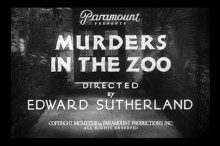
There’s an irony to this, since the film that prompted me to go ahead and order this set is not a Universal horror, but a Paramount one that Universal acquired—along with nearly everything else Paramount produced between 1928 and 1947—under the auspices of MCA years ago. That it’s also the best film in the set has more to do with the fact that the first wave of horror was superior to the second wave than it has anything to do with the studios. That Universal has yet to dole out the horror movie jewel of their Paramount holdings, Erle C. Kenton’s Island of Lost Souls (1933), probably comes under the heading of the realization that it’s the only way to sell those miserable Paula DuPree Ape Woman movies on down the line. (You don’t honestly think anyone bought their Wolf Man box set to get She Wolf of London [1946], do you?)
What do you get for your 50 buck investment? Well, aside from Murders in the Zoo, there’s The Strange Case of Dr. Rx (1942), The Mad Doctor of Market Street (1942), The Mad Ghoul (1943) and House of Horrors (1946). They come in a reasonably sound—though pretty unspectacular—package. By way of extras, there are some scene stills, publicity stills, lobby cards and posters—all of which are inconveniently anamorphically enhanced for widescreen TV. That’s a pretty odd move when you consider the movies themselves aren’t—and oughtn’t be—enhanced for widescreen. You also get some sketchy and not entirely correct onscreen production notes. (It’s very clear in The Strange Case of Dr. Rx that the gorilla played by Ray “Crash” Corrigan is called Nbongo, not Bongo as the notes keep insisting..)
Enticing? Not very. But you also get the films themselves, and they’re very enticing indeed if you’re a fan. With the exception of Murders in the Zoo these aren’t exactly the cream of the crop, but that’s almost beside the point in terms of liking them. Let’s be honest, if you really love classic era horror, you also love—or at least have a soft-spot for—the lesser luminaries. That’s especially true for anyone who watched these movies on TV growing up. In that regard, if fact, these 1940s B pictures are apt to have more resonance for some fans than Murders in the Zoo, since it was never a fixture on the “Shock Theater” circuit.
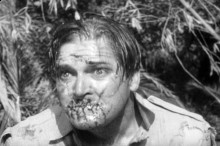
Murders in the Zoo benefits a good deal from Paramount’s production gloss and the fact that it’s a pre-code film. A year or so later and its grotesqueries—like the close-up of the man with his lips sewn shut, the cavalier disposal of Kathleen Burke into a pool of alligators, and Atwill’s comeuppance—would have been toned down considerably to satisfy the Breen Office. It’s an odd film to come from director A. Edward Sutherland, a man mostly associated with W.C. Fields movies and lighter fare. The only thing remotely comparable in his filmography is the very strange Secrets of the French Police (1932)—complete with its corpse turned into a statue a year ahead of Mystery of the Wax Museum—but even that isn’t really a horror picture. Murders in the Zoo very much is a horror film—with large doses of comedy.
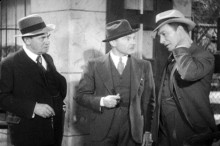
The film is a bit of a weird concoction, since the studio opted to build it around comic actor Charlie Ruggles as a press agent with a drinking problem, despite the story being all about big game hunter Eric Gorman (Lionel Atwill) dealing with his wife’s (Kathleen Burke) apparently endless string of boyfriends—in the most drastic manner possible. Ruggles, in fact, gets billing over Atwill, though Atwill gets special “and” billing on the opening credits. The reason isn’t hard to fathom. Ruggles was a Paramount contract player, while Atwill had been called in as a horror star thanks to Doctor X (1932), The Vampire Bat (1933) and Mystery of the Wax Museum (1933). It was in the studio’s interest to promote Ruggles. And even though comical drunks are harder to accept today, Ruggles certainly has his moments in the film and is much better than a lot of so-called comic relief in horror movies.
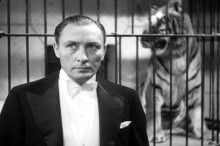
The film opens with the infamous lip-sewing business in French Indo China (of all locations), but quickly moves to New York and the zoo of the title, which Gorman presents with a raft of fresh animals brough back from his trip. (Presumably, he went to more places than French Indo China, since his collection is more diverse than that port of call would allow for.) In the meantime, Mrs. Gorman has picked up a new boy toy (John Lodge), whose presence excites Gorman to further lethal hijinks. But since this isn’t the jungle, he has to have a plan—and what a plan it is. He decides to off his rival with a portable snake-head filled with the venom of the deadly green mamba (a specimen of which he’s brough back). How, you ask? Well, at a posh fundraiser dinner at the zoo where it will be discovered that the mamba has escaped—thereby framing the hapless serpent with murder. Yes, of course, it’s preposterous, but that’s part of the fun.

Alas, Mrs. Gorman uncovers the truth and ends up on a hot date with alligators. (Yes, Gorman could have done this God knows how many boyfriends ago and saved himself a lot of exertion.) Ah, but he hasn’t reckoned with the real mamba being found and the wily Sherlockian deductions of heroic zoo herpetologist Randolph Scott, who thinks to measure the spread of the mamba’s fangs against the marks on the dead man’s leg. Much excitement ensues, including a spectacularly nasty ending for our villain—one that would have easily made my favorite deaths list for Halloween had I reseen the film recently.
Leaping ahead and into actual Universal horror, we have William Nigh’s The Strange Case of Dr. Rx (1942)—an oddball little film that I’ve loved for as long as I can remember. I’d have probably sprung for this set on the strength of this without Murders in the Zoo. And why not? I’ve already shelled out about 30 bucks over the years to grey market dealers for some watchable, but not very good copies. Seeing it with all its glossy sheen intact—this is one really great looking B picture—may not be revelatory, but it’s certainly a great pleasure to realize I’ve never seen it look this good.
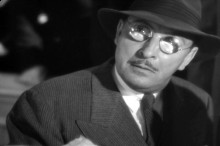
There’s always been a certain amount of resistance to Dr. Rx on two counts. First of all, it was heavily marketed as a Lionel Atwill movie, and, yes, Atwill as Dr. Fish receives second billing. He also receives three brief scenes with dialogue and one or two non-talking bits where he merely looks suspicious. As his name implies, the character of Dr. Fish is a red herring. (These days that little footage devoted to a name actor would have assured his guilt, but back then it merely meant the studio was cashing in on a name while only paying the actor for a couple days’ work.) More to the point is the fact that—apart from a hooded madman scene with some Frankensteinean lab equipment, a gorilla and some chatter about a brain tranfer between the imperiled hero and a gorilla—the movie is really a mystery and not a horror film. It is, however, a good deal of fun.
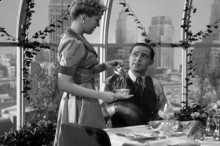
In reality, Dr. Rx is a kind of “Thin Man” affair with Gothic Horror trappings. Patric Knowles and Anne Gwynne play a detective and his mystery-writing girlfriend/wife. He’s involved in finding out who is behind the Dr. Rx killings—involving a vengeance-drive maniac who disposes of obviously guilty, but acquitted, murderers—and she becomes just as determined to stop him for his own good. Much of the film is played for comedy. Rumor has it that Knowles and Gwynne made up much of their bantering dialogue, but one suspects the ad libbing didn’t stop there. Also in the cast (though shockingly not billed on the opening credits) is the black comedian Mantan Moreland, who unleashes his very un-PC (but often very funny) schtick on the film—and a lot of it sounds like Moreland’s own material. Add to this, Shemp Howard as a dumb cop and the humor level is surprisingly high.
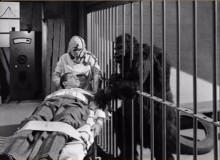
It’s also a nicely designed film. (I wouldn’t in the least mind living in the studio’s idea of a modern (1942 modern) posh New York apartment.) Plus, the mystery—despite its painfully obvious red herrings—is nicely developed. When you factor together the chemistry between Knowles and Gwynne, Moreland’s comedy, the terrific look of the movie, the hooded madman/gorilla scene and a brisk running time of 66 minutes, it’s a little miracle of a movie. In truth, it’s a shame that this kind of film has completely disappeared from screens today.

You get a lot more Lionel Atwill, but a lot less movie in Joseph H. Lewis’ The Mad Doctor of Market Street (1942). The fact that the movie was directed by Joseph H. Lewis means that it does boast a certain atmosphere. He uses Atwill in much the same way he had used Bela Lugosi the previous year in Invisible Ghost, which is to say that he likes to fill his frame with Atwill looking very sinister indeed and leering in on his intended victim. In fact, he likes this so much, it crops up three times. Atwill plays an outlaw scientist, Dr. Ralph Benson, who inadvertently offs a human guinea pig (Hardie Albright) in an experiment in suspended animation that goes awry. This, by the way, is the film’s only sequence that has anything to do with Market Street. Once the cops are closing in, Benson climbs out a window—and is next seen (having paused somewhere to shave off his beard) onboard a ship headed for the south seas.
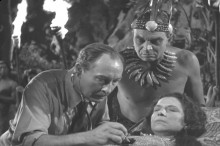
Whatever The Mad Doctor of Market Street lacks in terms of horror, it makes up for in sheer incident. We’re not on the ship for much longer than it takes Benson to off a detective and the romantic leads (Claire Dodd and Richard Davies) to fall for each other. Soon, the damned thing is on fire and our main characters—add Una Merkel as Dodd’s dithery aunt, Nat Pendleton as a moronic prizefighter and John Eldredge as a cowardly ship’s officer—find themselves on a tropical island. The natives—headed up by the legendary Noble Johnson (the native chief in King Kong)—think the white folks have brought evil spirits that are causing his wife (Rosina Galli) to lay dying. Naturally, he decides to set them on fire—till Benson shoots the old gal full of adrenalin when she expires and bring her “back to life.” This gets him set up as the God of Life.
It’s all on the silly side. One can only marvel at the advanced musical compositions of the islanders, not to mention their rituals, which look like LeRoy Prinz dance numbers out of a “Road” picture. It’s not bad, but it’s ultimately a little on the tepid side. Suspended animation and bogus raisings of the dead simply have limited appeal, I think. In its favor, Atwill enjoys his villainy and gets the most out of looking menacing or lecherous as the plot dictates. Curio seekers will note that the film has an extended—and so far as I know, unique—version of Universal’s stock music for the ending credits.

More to the point is James Hogan’s The Mad Ghoul (1943)—a film that debuted a scant eight days after its director’s death. Perhaps he was afraid of the critical response, which was predictably not kind. Indeed, the film received one review from a British critic, which may be the finest outburst of critical acumen I’ve ever seen—“To be a ghoul must be disconcerting enough. To be a mad ghoul must be the height of personal embarassment.” Who can dispute this? Certainly not the lackluster David Bruce in the title role—a bland actor briefly thrust into quasi-stardom by what was known as “victory casting.” (The war had caused a shortage in viable leading men.) How bland is Bruce? Well, let’s put it this way, when he turns into the extremely annoyed ghoul of the title he looks the worse for wear (thanks to effective Jack Pierce makeup), but he seems only slightly less animated and personable than in his human scenes. It’s no wonder that the leading lady (Evelyn Ankers) spends the entire movie trying to dump him.
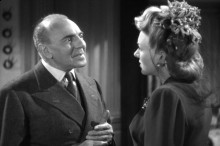
What the film has going for it—apart from taking itself agreeably seriously and not downplaying its grimness—is George Zucco as the libidinous and unhinged Dr. Alfred Morris, who turns Bruce into the ghoul. Zucco is at his utterly amoral, Satanic best here—gleefully out to prove his crackpot experiment while openly lusting after the leading lady. The experiment is of the loopy variety that is best not examined too closely. Seems Dr. Morris has divined that some ancient civilization or other (probably the Mayans from the look of things) had come up with a poison gas that produced the illusion of death, but one that could be rectified with the aid of a fresh heart and some chemicals. The exact point of this is unclear, but Morris has recreated (how is not addressed) the gas and the antidote and has monkeys at his disposal. So he taps a student (Bruce) to do the necessary cardiectomy on an ungassed monkey and manages to revive the gassed simian.
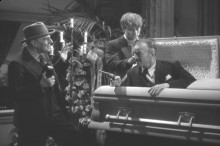
Naturally, he’s not satisfied with this. He wants to do it on a human being—and, well, he has the hapless student at hand, and anyway the student stands between him and the object of his lust. So ol’ Doc Morris gasses the lad, turning him into a zombie-like creature (why is not addressed), and then makes him get a heart from a fresh grave and uses it to revive him. But wouldn’t you know it, the effect is transitory, so we get a spree of grave-robbings and even a few murders to keep him going. It’s amusingly twisted nonsense that seems better than it is because of Zucco’s ability to seem privately amused by the whole thing.
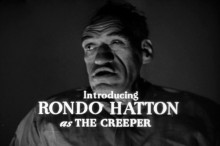
That brings us to Jean Yarbrough’s House of Horrors (1946). The film isn’t worthless. Martin Kosleck gives a notable performance as a deranged sculptor of the cubist school, but otherwise the film mostly manages to offer up the improbable combination of half-heartedness and desperation. According to the opening credits, it “introduces” Rondo Hatton as “The Creeper.” Considering that Hatton had already played that character in the Sherlock Holmes picture The Pearl of Death in 1944, it’s hard to understand how this introduces him. Anyway, it’s largely interchangeable with his other Universal horror appearances in Jungle Captive (1945) and The Spider Woman Strikes Back. In other words, he’s big hulking guy with unfortunate features and a propensity for breaking spines.
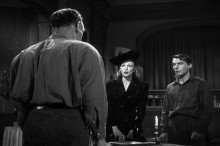
The truth is that Hatton actually looked like he does in the films, thanks to a glandular disease called acromegaly—a popular B picture affliction we’d seen in Black Dragons (1942) and The Monster Maker (1944). The difference is that Hatton really had the condition and the studio was happy to cash in on his misfortune. There’s no denying he was an impressive screen presence, but he can’t be viewed as much of an actor. He tends to say, “Stop screamin’,” a lot to women who object to having their spines broken, and is fairly good at that. House of Horrors, however, gives him considerably more dialogue and it’s not pretty. But then, neither is the film. It’s watchable and it has its interest as part of the death rattle of the Universal horrors, but it’ll be the least played disc in the collection.
Even if you’re not a horror fan, this new deal between TCM and Universal is very promising. Coming up next is a three film Cary Grant set, which isn’t really so much a Cary Grant set as it is three movies that can be marketed that way. The Devil and the Deep (1932) is really a Talluljah Bankhead movie co-starring Gary Cooper with Charles Laughton as her sadistic husband. Grant merely has a small role as her pre-Cooper boyfriend. The Eagle and the Hawk (1933) is an anti-war film that stars Fredric March with Grant very much in second place. The Last Outpost (1935) at least stars Grant, but it’s not a film of his you ever hear referred to. I haven’t seen it, but there may be good reason. The other titles, however, are a very welcome addition to DVD—and when you think what else Universal owns that hasn’t made it to home video, the prospects are tantalizing indeed.




I did manage to get a DVR of Murders in the Zoo, which is nice, also have the old VHS of it. Great horror flick, though I doubt I’ll pick up this new set since nothing else in it is all that notable. Not for 50 bucks.
Where is Island of Lost Souls anyway?
Great horror flick, though I doubt I’ll pick up this new set since nothing else in it is all that notable. Not for 50 bucks.
That gets to the kernel of my own argument against the manner in which TCM shows the films that they’re involved in bringing out commercially. It seems counterproductive to me on exactly this basis, since all you get — unless you’re a completist with a taste for 1940s Universal B horror — here that you couldn’t have gotten off the air is a copy of the film sans the occasional TCM logo popping up in the bottom corner of the screen.
At the same time, I was discussing this with a friend of mine who goes way back in the realm of collecting. He said much the same thing, but I pointed out to him that it wasn’t that long ago that we would’ve shelled out $150 for a beat-up 16mm TV print or a dupe copy of Bride of Frankenstein and considered ourselves lucky to have gotten it. Even in the VHS era, you often paid $50 to $90 for a single movie — at least early on. Here you’re paying ten bucks per movie. Our perceptions change.
Where is Island of Lost Souls anyway?
Probably exactly where I suggested — waiting to be packaged with a bunch of lesser titles that otherwise wouldn’t sell. At least it was released on laser meaning that there are good bootlegs out there. I’d personally love to see Murder by the Clock, Terror Aboard, Double Door and The Witching Hour come out — and even the strange Among the Living — but I’m not holding my breath. Murder by the Clock might show up, since it was at least in Everson’s Classics of the Horror Film and is slightly known, but the others…apart from an article I wrote for Scarlet Street on Paramount horror movies, I’ve never seen them even mentioned. Then again, my Paramount shopping list is a long one. With Universal, once you get past the horror pictures, James Whale and John M. Stahl, there’s not much that exciting. And considering that one of the “hipper” websites did an article on this first vault set and its title referred to these as “Old Ass” horror movies, suggesting that the modern mindset is not in sympathy with bothering with these things.
I’ve wanted to see Murder by the Clock for years, ever since reading about it in some horror book (perhaps the one you mentioned). Some of those others I’ve never heard of.
How about something like Follow Thru being put out on DVD? One of the few restored two color Technicolor films.
I’ve wanted to see Murder by the Clock for years, ever since reading about it in some horror book (perhaps the one you mentioned).
It’s not a great film, but it’s an amusing old dark house-ish affair with the great Lilyan Tashman and a gibbering idiot performance from Irving Pichel (this is what made Paramount want Mamoulian to use him in Dr. Jekyll and Mr. Hyde?).
Some of those others I’ve never heard of.
I’m not even mildly surprised.
How about something like Follow Thru being put out on DVD? One of the few restored two color Technicolor films.
I saw that in a b/w print and don’t recall being particularly impressed by it as a film. As Nancy Carroll musicals go, I’d rather see Honey come out. As Nancy Carroll films in general, I’d rather see Laughter. For two-strip Technicolor, I’d like to see The Vagabond King. I’ll make it easier — Whoopee!, which made it to VHS and laser, and King of Jazz, which made it to VHS. Not that I wouldn’t buy Follow Thru, mind you.
King of Jazz is in bad shape and needs to be restored for DVD, wonder if that is why it hasn’t come out? Whoopee IS in some huge MGM box set of musicals but I don’t think it’s ever been out on its own. There should certainly be some sort of Cantor 1930-36 era box set.
King of Jazz is in bad shape and needs to be restored for DVD, wonder if that is why it hasn’t come out?
Bad shape? I don’t recall it being in any worse shape than a number of things I’ve seen come out.
Whoopee IS in some huge MGM box set of musicals but I don’t think it’s ever been out on its own.
Are you sure of this? It’s not owned by MGM — unless something has changed.
Here you’re paying ten bucks per movie. Our perceptions change.
What’s funny is that people will still complain about the price. If it ain’t free then it’s too much.
I’ve been picking up the Warner Archives series and am looking forward to this set. I’m happy another studio has picked up Warner’s idea.
It’s been awhile since I’ve seen MURDERS AT THE ZOO, but I remember liking it a lot. We had a vhs copy for sale downtown for awhile, but some lucky customer snagged it before I could see it again.
The mega set that Whoopee is in is called simply Hollywood Musicals and there doesn’t seem to be a set studio. There are Goldwyn movies, Fox, UA, and so on. Kid Millions is another Cantor that is in that set. It costs about 450.00 on amazon.com and has 60 movies.
I found my old VHS of King of Jazz during the summer. The print is in bad shape and in need of restoration for DVD, not to mention it is missing about 12 mins. from the original release.
What’s funny is that people will still complain about the price. If it ain’t free then it’s too much.
Oh, I understand Brian not wanting to pay $50 in order to get one film he wants and four he doesn’t especially want. But as someone screwy enough to once take out a signature loan in order to buy a 16mm bootleg reduction of Tommy for $425 (and that’s 425 1977 dollars), I’m easily impressed with the idea of $10 a movie.
I’ve been picking up the Warner Archives series and am looking forward to this set. I’m happy another studio has picked up Warner’s idea.
I haven’t bought any of those yet. They mostly are things I’m cool with having recorded off TCM. They own things I would buy, but haven’t brought them out yet. I hear there are plans to bring out all the Al Jolson films — and even though I have all of them from laserdisc, I’d buy ’em.
The mega set that Whoopee is in is called simply Hollywood Musicals and there doesn’t seem to be a set studio.
Yeah, I found it. It seems to be somehow attributed to MGM and Fox. I’m still not clear how either one has claim to a couple Goldwyn films. In any case, it’s a damned odd set. Virtually everything in it I’d want, I have except Whoopee!, but since I do have it from laserdisc, there’s not even the slightest urge to end up with a copy of Flaming Star or Oklahoma!.
I found my old VHS of King of Jazz during the summer. The print is in bad shape and in need of restoration for DVD, not to mention it is missing about 12 mins. from the original release.
I’d still buy it. The missing 12 minutes may not even exist. A restoration would be nice, but whether there’s a call for it is another matter. Consider the shabby prints of The Cocoanuts that they continue to sell (for which there may be some justification), to say nothing of that chewed-up, chopped up Horse Feathers (harder to justify).
The Warner Archive site does in fact have a ton of Jolson stuff on it now. Singing Fool, Mammy, Big Boy and all that sort of stuff.
There are some gangster titles on there that should have been out on a real DVD release, movies like The Big House, Beast of the City, and 20,000 Years in Sing Sing. The problem with the first 2 is that they are MGM movies and thus don’t fit a Warner Gangster set (MGM and tough guys don’t mix I guess). I guess 20,000 Years doesn’t fit a Warner set since it didn’t have Cagney, Bogart, or Robinson in it. Spencer Tracy as a gangster didn’t 100% work.
I looked up those other rare Paramount horrors on imdb.com and some sound really cool. Terror Aboard sounds especially deranged.
The Warner Archive site does in fact have a ton of Jolson stuff on it now. Singing Fool, Mammy, Big Boy and all that sort of stuff.
This is one of the flaws with the Archive site — there’s not sufficient news released when something comes out. Or maybe I just don’t follow it closely enough. Now, Mammy is one of those titles where it’s long been rumored that there is a Technicolor print in an archive, but I’m betting this is still the b/w print.
There are some gangster titles on there that should have been out on a real DVD release, movies like The Big House, Beast of the City, and 20,000 Years in Sing Sing. The problem with the first 2 is that they are MGM movies and thus don’t fit a Warner Gangster set (MGM and tough guys don’t mix I guess).
Well, turnabout is fair play. God knows, MGM has never been shy about putting out collections where most of the titles are actually WB. Then again, if you’re MGM, it’s probably in your favor to claim other studios’ work. My own problem with those titles is that I don’t much like any of them, though The Big House is at least interesting.
I looked up those other rare Paramount horrors on imdb.com and some sound really cool. Terror Aboard sounds especially deranged.
At least it used to be fairly common on the grey market (at least in the VHS era). It — somewhat like Columbia’s Night of Terror — is a kind of high body-count film. The others are probably less interesting. Double Door is an oddity that was made from a briefly popular play and stars the woman from the stage, Mary Morris (her only film). Paramount then thrust their rather minor screen team of Evelyn Venable and Kent Taylor (mostly remembered for Death Takes a Holiday) into it. It’s years since I saw The Witching Hour, but I remember liking it a good deal and being particularly impressed with Sir Guy Standing’s performance. Again, I don’t remember Among the Living all that clearly, but I do remember it as very odd and rather creepy.
I was unaware of the Warner Archive site until this weekend. I was excited to see they had a five-disc set of Lex Barker Tarzan films, all of the Gordon Scott Tarzan films from the 50s and early 60s and a rare 50s ‘horror’ title I’ve sought for years: It Came from Hell, the grandaddy of all walking killer tree movies.
They do seem to have many more comedy titles than anything else, though.
It Came from Hell, the grandaddy of all walking killer tree movies.
Name me a better one! (Except it’s From Hell It Came.)
“Name me a better one! (Except it’s From Hell It Came.)”
Yeah, you’re correct. I did get the title a bit backwards.
A better one? No way, although some might try and make the case that Day of the Triffids featured better walking killer trees. I don’t believe they were trees, however. Some kind of alien walking bush, maybe.
Some kind of alien walking bush, maybe.
Usen’t he be president?
In addition to DAY OF THE TRIFFIDS which still doesn’t have a quality DVD release, there’s 1958’s THE WOMAN EATER (although the tree doesn’t move) with George Coulouris that does.
“In addition to DAY OF THE TRIFFIDS which still doesn’t have a quality DVD release, there’s 1958’s THE WOMAN EATER (although the tree doesn’t move) with George Coulouris that does.”
I agree that there is no decent quality release of the movie. Even a crummy version is now out-of-print and going for far more than it’s worth.
There is another version of the movie, a British production that is now available on DVD that’s actually pretty good, with a somewhat different slant; in this version, the Triffids produce a valuable petroleum-like product, so they are kept penned up like cattle.
As for The Woman Eater, I bought that title several years ago and have yet to watch it. Since there now is a kind of competition for best killer tree movies, I need to check it out. Thanks.
Somehow or other, I’ve completely missed The Woman Eater. I feel strangely deprived.
As a longtime fan of BBC (British Bad Cinema), I have recently been revisiting such 1950s fare as KONGA, THE WOMAN EATER, and the wonderfully redundant THE GIANT BEHEMOTH which really isn’t all that bad considering the $1.98 budget.
Have you ever seen WOMAN EATER’s companion film THE MAN WITHOUT A BODY (also with Coulouris) about transplanting the head of Nostradamus? It doesn’t seem to be currently available.
Then there’s X THE UNKNOWN. Dean Jagger’s finest hour (possibly Anthony Newley’s too). The melting doctor remains one of my favorite sci-fi shock effects. It’s also your one chance to see future MONTY PYTHON director Ian MacNaughton.
the wonderfully redundant THE GIANT BEHEMOTH which really isn’t all that bad considering the $1.98 budget.
This film resonates in my memory as the first movie I ever saw that tried to evoke tears by showing a child’s doll floating in the water. I vaguely recall it as being not too bad, but I might have recently seen Reptilicus at the time — and that makes most giant monster movies look pretty good.
Have you ever seen WOMAN EATER’s companion film THE MAN WITHOUT A BODY (also with Coulouris) about transplanting the head of Nostradamus? It doesn’t seem to be currently available
I am pretty sure that occasional poster Harry Long sent me a copy of it –possibly on VHS. If that’s true, I’m up a tree since I’m currently VHS-less.
Then there’s X THE UNKNOWN. Dean Jagger’s finest hour (possibly Anthony Newley’s too). The melting doctor remains one of my favorite sci-fi shock effects.
Haven’t seen this in ages. I don’t remember liking it much, but after seeing Jagger in the appallingly dismal Revolt of the Zombies, I’m sure it’s at least a finer hour for him than that. Until I catch up with Can Heironymus Merkin Ever Forget Mercy Humppe and Find True Happiness?, I withold judgment on Anthony Newley’s finest moment.
“As a longtime fan of BBC (British Bad Cinema), I have recently been revisiting such 1950s fare as KONGA, THE WOMAN EATER, and the wonderfully redundant THE GIANT BEHEMOTH which really isn’t all that bad considering the $1.98 budget.
Have you ever seen WOMAN EATER’s companion film THE MAN WITHOUT A BODY (also with Coulouris) about transplanting the head of Nostradamus? It doesn’t seem to be currently available.
Then there’s X THE UNKNOWN. Dean Jagger’s finest hour (possibly Anthony Newley’s too). The melting doctor remains one of my favorite sci-fi shock effects. It’s also your one chance to see future MONTY PYTHON director Ian MacNaughton.”
I’m also a long-time fan of British cinema, especially science fiction and horror films. I find they tend to be a bit more cerebral.
The Giant Behemoth left an impression on me when I saw it as a kid. The scene where the beast irradiated (and killed) the farmer and his son was pretty scary, and I liked the scene (I think using Willis O’Brien’s ‘behemoth’) where the monster ransacked London. I have that film on DVD and have watched it a couple of times in the last year or so.
I never heard of The Man Without a Body, but it sounds worth seeking out.
X The Unknown, a Quatermass clone, was also an enjoyable film. Dean Jagger was lacking in the charisma department (although not as deficient as Brian Donlevy in the first two Quatermass films).
I’m surprised to see Ken reference ‘…Heironymus Merkin…” I thought I was one of a few people on the planet that saw this film when it was released. The only scene I remember was a, well, risque underwater scene. Those who saw it will recall, I’m sure.
I’m surprised to see Ken reference ‘…Heironymus Merkin…” I thought I was one of a few people on the planet that saw this film when it was released.
Bear in mind, I only referenced it and haven’t seen it.
“Bear in mind, I only referenced it and haven’t seen it.”
Well, if you ever do see it, the aforementioned scene will be indelibly etched in your memory.
Damm you, Hanke! Damm you to hell! Now I have to order yet another DVD set. Yeah, my collection is only about 1200 titles. Pretty small potatoes by movie buff standards. But I’m pretty proud of the fact that most of them are black and whites. Now, once again my marriage is threatened and the need to build another set of shelves in my dark, dank, dingy basement screening room rears it’s ugly head. When will it all end? Perhaps I need to acquire a race of atomic supermen to carry out the construction.
Well, if you ever do see it, the aforementioned scene will be indelibly etched in your memory.
I’m just amazed that the title got past the MPAA. I guess they didn’t understand it.
Damm you, Hanke! Damm you to hell!
Eventually, no doubt.
Now I have to order yet another DVD set. Yeah, my collection is only about 1200 titles. Pretty small potatoes by movie buff standards.
That’s fairly impressive really. It’s less than I’ve amassed, yes, but then I have the excuse of picking things up because they might be good to have on hand for research purposes.
But I’m pretty proud of the fact that most of them are black and whites.
I’ve never thought about in those terms, but I’d be willing to bet I have a good many more b/w titles than color ones, but I doubt I could say “most.”
Perhaps I need to acquire a race of atomic supermen to carry out the construction.
Well, Dr. Vornoff was going to use them to “conquer de world,” so I think conquering the basement seems a reasonable desire. Might’ve worked better for Dr. Vornoff, too, considering his budget.